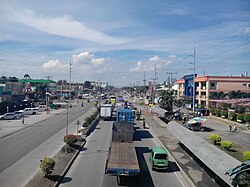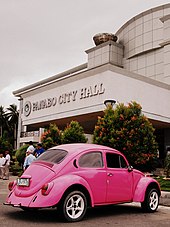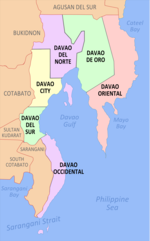Panabo
Panabo | |
|---|---|
| City of Panabo | |
 Downtown area | |
| Nickname: Banana Capital of Davao del Norte | |
 Map of Davao del Norte with Panabo highlighted | |
Location within thePhilippines | |
| Coordinates:7°18′N125°41′E/ 7.3°N 125.68°E | |
| Country | Philippines |
| Region | Davao Region |
| Province | Davao del Norte |
| District | 2nd district |
| Founded | July 19, 1949 |
| Cityhood | March 31, 2001 |
| Barangays | 40 (seeBarangays) |
| Government | |
| • Type | Sangguniang Panlungsod |
| •Mayor | Jose E. Relampagos (Reporma) |
| •Vice Mayor | Janrey G. Gavina (HNP) |
| •Representative | Alan R. Dujali (HNP) |
| •City Council | Members |
| •Electorate | 127,668 voters (2022) |
| Area | |
| • Total | 251.23 km2(97.00 sq mi) |
| Elevation | 74 m (243 ft) |
| Highest elevation | 555 m (1,821 ft) |
| Lowest elevation | 0 m (0 ft) |
| Population (2020 census)[3] | |
| • Total | 209,230 |
| • Density | 830/km2(2,200/sq mi) |
| •Households | 51,097 |
| Demonym | Panaboan |
| Economy | |
| •Income class | 3rd city income class |
| •Poverty incidence | 18.46 |
| •Revenue | ₱ 1,307 million (2020) |
| •Assets | ₱ 3,770 million (2020) |
| •Expenditure | ₱ 1,093 million (2020) |
| •Liabilities | ₱ 819.9 million (2020) |
| Service provider | |
| •Electricity | Davao Light and Power Company(DLPC) |
| Time zone | UTC+8(PST) |
| ZIP code | 8105 |
| PSGC | |
| IDD : area code | +63 (0)84 |
| Native languages | Ata Manobo Davawenyo Cebuano Kalagan Tagalog |
| Website | www |
Panabo,officially theCity of Panabo(Cebuano:Dakbayan sa Panabo;Filipino:Lungsod ng Panabo), is a 3rd classcomponent cityin theprovinceofDavao del Norte,Philippines.According to the 2020 census, it has a population of 209,230 people.[3]
Panabo is part ofDavao Metropolitan Areaas it shares borders withDavao City.It has an area of 25,123 hectares (62,080 acres). The Panabo City Hall is located about 2.23 kilometers from its boundary with Davao City.
Etymology
[edit]The name Panabo originated from the phrase "pana-sa-boboy"where"pana"means" arrow ", the tool which the original inhabitants of the place, theAetas,use when hunting wild animals for food.[5]
History
[edit]Originally the rich lowland of what today is Panabo was inhabited by a group of natives calledAetas.These people led nomadic life and lived by hunting. With the use of their most essential tool, the bow and arrow— "pana-sa-boboy"as they call it—they hunted for food which primarily consisted of rootcrops and meat of wild boars.[5]
Settlers and pioneers from theVisayasandLuzonstarted to flock the place during the early 1900s in search of a new life in the region. When the first batch of settlers arrived on the place, in what is now the urban core of the city, they found out that it was already a thriving community, and thus called itTaboan,or trading center. Feeling alienated with the massive influx of settlers in the region, the Aeta natives moved further into the hinterlands to the west, thus ensuring that the settler inhabitants become the majority of the population. The new inhabitants started to name the place as Panabo, named after the bow and arrow that the Aeta natives always carry.
Panabo, until then only a mere barangay ofTagum,then known as Magugpo during that time, became a town on July 19, 1949, through Presidential Proclamation No. 236 of the PresidentManuel A. Roxas.
The Tagum Agricultural Development Company, otherwise known as TADECO, was founded on December 20, 1950, in the town of Panabo.[6]It was the birth of the world's largestCavendish bananaplantation that saw the mass employment of the locals seeking for jobs, and the start of unprecedented growth of the town as even larger throngs of Visayan migrants settled on the town eager to join the plantation's workforce. Large areas of forests were cleared to make way for the banana trees under TADECO. The town of Panabo grew both in economic terms and population as decades passed since the founding of TADECO and numerous businesses were then set up locally, until the conditions finally warranted for its conversion into a city.
Cityhood
[edit]The local government unit of Panabo was created into a component city of Davao del Norte by virtue of Republic Act No. 9015[7]and ratified by the residents in a plebiscite held on March 31, 2001. However, its official existence as a municipal corporation took effect on with the appointment of new set of officials.
Geography
[edit]The city of Panabo has a total land area of 251.23 km2.It was bordered by the shores ofDavao Gulfto the east, byDavao Cityto its west and south, and some of the municipalities ofDavao del Nortein the north. The western part of the city featured hills while the rest were flatlands.
Climate
[edit]| Climate data for Panabo City | |||||||||||||
|---|---|---|---|---|---|---|---|---|---|---|---|---|---|
| Month | Jan | Feb | Mar | Apr | May | Jun | Jul | Aug | Sep | Oct | Nov | Dec | Year |
| Mean daily maximum °C (°F) | 29 (84) |
30 (86) |
30 (86) |
30 (86) |
31 (88) |
31 (88) |
30 (86) |
30 (86) |
30 (86) |
30 (86) |
30 (86) |
30 (86) |
30 (86) |
| Mean daily minimum °C (°F) | 22 (72) |
22 (72) |
22 (72) |
22 (72) |
23 (73) |
24 (75) |
24 (75) |
24 (75) |
24 (75) |
24 (75) |
23 (73) |
22 (72) |
23 (73) |
| Averageprecipitationmm (inches) | 98 (3.9) |
86 (3.4) |
91 (3.6) |
83 (3.3) |
133 (5.2) |
158 (6.2) |
111 (4.4) |
101 (4.0) |
94 (3.7) |
117 (4.6) |
131 (5.2) |
94 (3.7) |
1,297 (51.2) |
| Average rainy days | 16.4 | 14.3 | 16.3 | 18.5 | 25.3 | 25.0 | 23.8 | 21.9 | 20.8 | 24.4 | 24.3 | 18.7 | 249.7 |
| Source: Meteoblue(modeled/calculated data, not measured locally)[8] | |||||||||||||
Barangays
[edit]Panabo is politically subdivided into 40barangays.[9]Each barangay consists ofpurokswhile some havesitios.
Quezon was formerly the sitio of Cabili; it became a barrio in 1957.[10]
- A. O. Floirendo
- Datu Abdul Dadia
- Buenavista
- Cacao
- Cagangohan
- Consolacion
- Dapco
- Gredu (Poblacion)
- J.P. Laurel
- Kasilak
- Katipunan
- Katualan
- Kauswagan
- Kiotoy
- Little Panay
- Lower Panaga (Roxas)
- Mabunao
- Maduao
- Malativas
- Manay
- Nanyo
- New Malaga (Dalisay)
- New Malitbog
- New Pandan (Poblacion)
- New Visayas
- Quezon
- Salvacion
- San Francisco (Poblacion)
- San Nicolas
- San Pedro
- San Roque
- San Vicente
- Santa Cruz
- Santo Niño (Poblacion)
- Sindaton
- Southern Davao
- Tagpore
- Tibungol
- Upper Licanan
- Waterfall
Demographics
[edit]
|
| |||||||||||||||||||||||||||||||||||||||
| Source:Philippine Statistics Authority[11][12][13][14] | ||||||||||||||||||||||||||||||||||||||||
Economy
[edit]Poverty incidence of Panabo
5
10
15
20
25
30
2006
24.50 2009
14.77 2012
16.58 2015
19.10 2018
8.65 2021
18.46 Source:Philippine Statistics Authority[15][16][17][18][19][20][21][22] |

Being an agro-industrial city, Panabo is known as the "Banana Capital of the Philippines" due to numerous banana plantations scattered throughout the city. In fact, Panabo is the home of the world's biggest banana plantation, which is owned by the Tagum Agricultural Development Company (TADECO), which covers around 6,900 hectares of banana fields and produce millions of boxes of export-quality bananas annually. The city itself cultivated 40% of its land or around 10,000 hectares into planting export-qualityCavendish bananas.Thus, banana cultivation and exportation are the main economic lifeblood of the city.
Infrastructure
[edit]
There are two privately owned port facilities in the city, which enabled them to export various fruits, such as bananas, mangoes, papayas, and pineapples, to countries likeJapan,South Korea,China,and countries as far in theMiddle Eastand theEuropean Union.
Public infrastructure includes the Freedom Park which features a unique banana inspired fountain sculpted by the world class artistKublai Millan.The Panabo Multi-Purpose Cooperative Tourism Gymnasium, located beside the City Hall is also a public infrastructure, thegymnasiumaccommodates an estimated ten-thousand people and also serves as playing venue of thePhilippine Basketball Associationas well as serving concerts for the city.
Transportation
[edit]Panabo is served by the 6-laneMaharlika Highwayand is a highway road junction heading to the TADECO banana plantation as well as to other parts ofDavao del Norteand the northernmost areas ofDavao City.Tricycles andjeepneysare the main mode of transportation in the city, while passenger buses and public utility vans serve overland routes within and outside the city.
Education
[edit]Tertiary education
[edit]Universities
- University of Mindanao,Panabo College (private)
- Davao del Norte State College(public)
Colleges
- ACES Polytechnic College, Inc.
- Maryknoll College of Panabo, Inc.
- North Davao Colleges
- NorthLink Technological College, Inc.
- Valiant Technological College
- Northern Paramedical and Technological College, Inc.
- The Leores Training Academy Inc.
Secondary education
[edit]High-schools
- Davao del Norte State College Laboratory School(private)
- North Davao Colleges - High School Department (private)
- Maryknoll College of Panabo(private)
- Francisco Adlaon Learning Institute (private)
- Panabo SDA Learning Center (private)
- Panabo Christian School (private)
- Panabo City Senior High School (public)
- Panabo Achievers Academy (2nd year only) (private)
- Panabo City National High School (public)
- Little Panay National High School
- Colegio de Davao, Panabo City (Private)
- Good Shepherd Baptist School (Church School)
- A. O. Floirendo National High School
- Cagangohan National High School
- Don Manuel A. Javellana Memorial National High School
- Kasilak National High School
- Kauswagan National High School
- Mabunao National High School
- Malativas National High School
- Manay National High School
- Quezon National High School
- San Vicente National High School
- Sindaton National High School
- Southern Davao National High School[23]
A memorandum of agreement betweenUP Los Baños College of Agricultureand ANFLOCOR was signed for the establishment of UP Professional School for Agriculture and the Environment (UP PSAE) which will be UPLB's extension campus in Panabo City.[24][25][26]In addition,UP Mindanaowill also collaborate on some courses and programs to be offered.[27]
Notable personalities
[edit]- Jerwin Ancajas,boxer
- Dennis Denora,journalist and publisher
- Thor Dulay,The Voice Ph semifinalist
- Jasmine Bacurnay Lee,Korean actress and politician
Sister cities
[edit]Local
[edit]References
[edit]- ^ City of Panabo|(DILG)
- ^"2015 Census of Population, Report No. 3 – Population, Land Area, and Population Density"(PDF).Philippine Statistics Authority.Quezon City, Philippines. August 2016.ISSN0117-1453.Archived(PDF)from the original on May 25, 2021.RetrievedJuly 16,2021.
{{cite web}}:CS1 maint: year (link) - ^abCensus of Population (2020)."Region XI (Davao Region)".Total Population by Province, City, Municipality and Barangay.Philippine Statistics Authority.RetrievedJuly 8,2021.
- ^"PSA Releases the 2021 City and Municipal Level Poverty Estimates".Philippine Statistics Authority. April 2, 2024.RetrievedApril 28,2024.
- ^ab"City Profile".Local Government of Panabo City. Archived fromthe originalon December 31, 2012.RetrievedApril 30,2014.
- ^"Incorporated (TADECO, Inc.), Tagum Agricultural Development Company".www.globalgap.org.
- ^"Republic Act No. 9015 | GOVPH".
- ^ "Panabo: Average Temperatures and Rainfall".Meteoblue.RetrievedFebruary 29,2020.
- ^"City of Panabo - Code:112315000 - Philippine Standard Geographic Code (PSGC)".psa.gov.ph.Philippine Statistics Authority.RetrievedFebruary 22,2022.
- ^"An Act Converting the Sitio of Cabili, Municipality of Panabo, Province of Davao, into a Barrio of Said Municipality to Be Known As the Barrio of Quezon".LawPH.com.RetrievedApril 12,2011.
- ^Census of Population (2015)."Region XI (Davao Region)".Total Population by Province, City, Municipality and Barangay.Philippine Statistics Authority.RetrievedJune 20,2016.
- ^Census of Population and Housing (2010)."Region XI (Davao Region)"(PDF).Total Population by Province, City, Municipality and Barangay.National Statistics Office.RetrievedJune 29,2016.
- ^Censuses of Population (1903–2007)."Region XI (Davao Region)".Table 1. Population Enumerated in Various Censuses by Province/Highly Urbanized City: 1903 to 2007.National Statistics Office.
{{cite encyclopedia}}:CS1 maint: numeric names: authors list (link) - ^ "Province of Davao del Norte".Municipality Population Data.Local Water Utilities AdministrationResearch Division.RetrievedDecember 17,2016.
- ^"Poverty incidence (PI):".Philippine Statistics Authority.RetrievedDecember 28,2020.
- ^"Estimation of Local Poverty in the Philippines"(PDF).Philippine Statistics Authority. November 29, 2005.
- ^"2003 City and Municipal Level Poverty Estimates"(PDF).Philippine Statistics Authority. March 23, 2009.
- ^"City and Municipal Level Poverty Estimates; 2006 and 2009"(PDF).Philippine Statistics Authority. August 3, 2012.
- ^"2012 Municipal and City Level Poverty Estimates"(PDF).Philippine Statistics Authority. May 31, 2016.
- ^"Municipal and City Level Small Area Poverty Estimates; 2009, 2012 and 2015".Philippine Statistics Authority. July 10, 2019.
- ^"PSA Releases the 2018 Municipal and City Level Poverty Estimates".Philippine Statistics Authority. December 15, 2021.RetrievedJanuary 22,2022.
- ^"PSA Releases the 2021 City and Municipal Level Poverty Estimates".Philippine Statistics Authority. April 2, 2024.RetrievedApril 28,2024.
- ^"Philippines Schools: Panabo City Public High School".July 17, 2012.
- ^"University of the Philippines los Baños - UP-ANFLOCOR sign MOA to develop the UP Prof'l School in Davao".Archived fromthe originalon March 21, 2017.RetrievedMarch 21,2017.
- ^"University of the Philippines los Baños - UPLB's harvest on its 108th foundation day: A" refocused "CAFS, a Davao campus, best personnel".Archived fromthe originalon March 21, 2017.RetrievedMarch 21,2017.
- ^"UPLB to put up satellite campus in Panabo City".June 29, 2016.
- ^"University of the Philippines Alumni".Archived fromthe originalon March 21, 2017.RetrievedMarch 21,2017.








